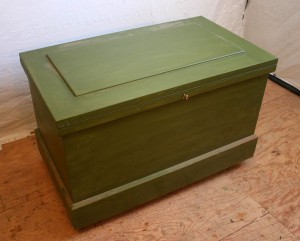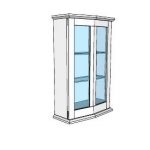We may receive a commission when you use our affiliate links. However, this does not impact our recommendations.
I examined lots of tool chests when researching “The Anarchist’s Tool Chest,” and found that their designs fell into two broad categories:
1. The plain and simple pine boxes with trays.
2. The pre-industrial monster truck chest with scantily clad tarts, parquetry, secret compartments and a bottle opener.
You don’t see a lot of chests that tread the middle ground between Country Mouse and Louis XIV Mouse. So I was quite pleased to get these photos from reader Matthew Sullenbrand. He took the basic design from “The Anarchist’s Tool Chest” and added some furniture-like woods and details that make the chest something I would build and something I actually could build.
“I broke every one of your rules, at least a little bit, but it would not be anarchical if I did not go against the grain,” Matthew wrote. “It all started with some walnut scraps that I was given, including an 18″-wide plank that became the panel for the lid. Slippery slope from there. But, I do think that much of the bling I added will be quite functional.”
What Matthew means by “bling” includes the lid to the top tray that is attached to the carcase of the chest and not the till itself. I’ve seen many chests that sport a lid attached to the top sliding tray, but I don’t think I’ve seen one that was attached to the carcase. Its primary advantage is that it will protect the tools when the top tray is slid all the way back. The secondary advantage, as I see it, is that the open lid will not interfere with the woodworker’s ability to snatch a tool from the sliding trays or drawers.
I’ll be interested to see how he likes it in the long term.
One of the other modifications Matthew made was to incorporate three drawers into the middle till. I dislike drawers for tool storage because they conceal their contents and end up creating several strata of tools in each drawers. This dislike is based in my own failings as a user of drawers.
“I know, drawers can be a bad idea,” Matthew writes. “But, only three, and one is dedicated for carving tools, one for chisels, and one for small things like nailsets and the like that can tend to get lost. Plus, when I want to carve, I just take out the carving drawer and set it on the bench. We will see.”
Tool chests have a lot of lessons to teach us, both about tool selection and tool storage. They also are good way to learn dovetailing without having to pull your pants down for a customer.

“It was a ton of fun to build and I learned an immense amount,” Matthew wrote. “By the end, I was dovetailing the drawers without marking the slopes, and they were the best fitting dovetails I have made to date.”
— Christopher Schwarz
“The Anarchist’s Tool Chest” is available in ShopWoodworking.com here with free domestic shipping.
Here are some supplies and tools we find essential in our everyday work around the shop. We may receive a commission from sales referred by our links; however, we have carefully selected these products for their usefulness and quality.













Functionality is paramount, but a little sexy thrown in is great. Much like myself.
Beautiful chest…its does seem logical, and ‘anarchistic’ to adjust the form and style to the craftsman’s sensibilities. I just toured the Duncan Phyfe exhibit at the Metropolitan Museum in NY. See: http://www.metmuseum.org/exhibitions/listings/2011/duncan-phyfe-master-cabinetmaker-in-new-york
Certainly an incredible display of furniture, but also includes his toolchest, which on the outside is plain, but on the inside matches his furniture – read that as wow. Definitely worth a visit.
Beautiful work.
The green colour is everything I had hoped for in my chest. (which sadly ended up purple by a mixing mistake..). I especially like the look of the inner lid, very nice indeed.
Question about tool chest design. The tool chests of three of the joiners (joiners, not cabinetmakers) working at Colonial Williamsburg have two tills, one on each side, and the front-to-back depth of each till is approximately 1/3 the overall interior depth. Both tills slide. There were various arrangements for bins and drawers in the tills. Advantages of the two till design appear to be greater volume of till space, and the individual tills are lighter to lift out. Chris – did you consider a two till arrangement when you designed the anarchist’s tool chest?
Skyblew: look closer.. the top till is 2 layers .. tray & drawers in 1 unit .. and a bottom for that unit encloses the drawers. Also you see 6 screw heads in the top tray that hold the drawer dividers.
And.. The saw rack is deeper than the bottom till: remove the walnut ‘floor’ visible in other photos to reveal the deep cavity. Note brass finger-pull to lift out the floor.
Lovely work, Matthew.
Matthew’s chest is very nice but I don’t understand how the middle and bottom tills work. Looks as if there are rails on the carcass for the middle till but what supports the center part of the drawers when pulled forward?
The third photo shows a saw rack in the bottom which would preclude the bottom till from being pulled out. Is the saw rack installed inside the bottom till?